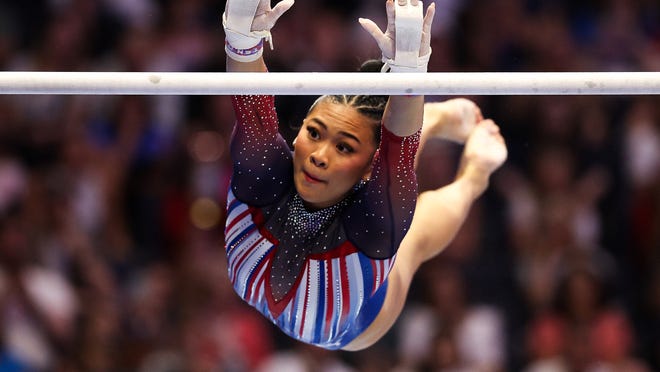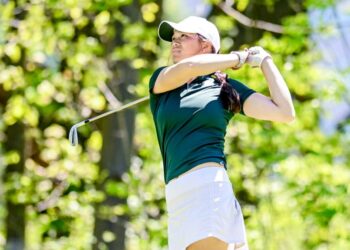MINNEAPOLIS — The U.S. gymnastics selection committee had only 25 minutes Sunday night to pick the five members of the women’s team that it would send to the Paris Olympics.
It’s seems like a distressingly brief window of time. But Alicia Sacramone Quinn said the committee members ultimately didn’t even need all of it.
The decisions, she said, were made in 10 or maybe 15 minutes.
“Honestly, it was a pretty cut-and-dry, easy decision,” said Quinn, the women’s strategic lead for USA Gymnastics.
By easy, of course, Quinn means it was straightforward. Emotionally, as with any decision that could mean crushing an athlete’s Olympic dreams, it was taxing.
Get Olympics updates in your texts! Join USA TODAY Sports’ WhatsApp Channel
“Obviously emotions get tied in, and we all care about these athletes so much, and we’re invested. So that gets hard,” Quinn added. “But I think we went by team scenarios and what we saw in the numbers and it just made sense.”
After weeks and months of prognosticating and number-crunching, two nights of competition at the U.S. Olympic trials in Minneapolis − and, unfortunately, a string of serious injuries that knocked out three of the top contenders − there was one clear answer to the committee’s Paris puzzle. The team includes a quartet of veterans who competed at the 2021 Tokyo Olympics − Simone Biles, Suni Lee, Jordan Chiles, and Jade Carey − plus a 16-year-old newbie, Hezly Rivera. Joscelyn Roberson and Leanne Wong will serve as traveling alternates.
THE GOAT: Simone Biles earned this US Olympic gymnastics team spot, and she deserves this happiness
Quinn, who is one of three members on the selection committee, said earlier this week that the committee would not automatically take the top-five athletes from the all-around competition. But that’s how it worked out, largely because the fifth-place finisher, Rivera, has strengths in events where the rest of the team has weaknesses.
“That fifth spot kind of came down to what we felt like we were lacking as a team, and that was bars and beam,” Quinn said. “Hezly really just delivered tonight, putting up two great scores. And we went back and compared her start value, her execution, and we felt like she’d be a good person to fill that last spot.”
At the Paris Games, which begin July 26, the team competition in women’s gymnastics consists of two rounds. In qualifying, each country will pick four of its five athletes to compete on each apparatus − vault, uneven bars, balance beam, and floor exercise − and then drop the lowest score on each. In the final, each country gets only three athletes per apparatus − and every score counts toward the team total.
Because of that format, the athletes, coaches, and selection committee all more or less understood how athletes’ performances on certain events would impact the shaping of the team.
Carey, for example, knew she needed to put up big scores on her two best events: Floor exercise and vault. For Rivera, it was about balance beam and uneven bars.
“Bars and beam are definitely what I think I can contribute to the team,” said Rivera, who is on track to be the youngest member of Team USA in any sport. “When I hit bars and beam, I kind of knew, yeah, I have a shot.”
For the U.S. men’s gymnastics team, which was selected Saturday, U.S. leaders locked in the best team using a computer program that calculated the best possible team scores. The women’s team selection, meanwhile, was at the discretion of the committee, which includes Tatiana Perskaia and Jessie DeZiel alongside Quinn.
Injuries to Skye Blakely, Kayla DiCello, and Shilese Jones only further muddled the process. Blakely and DiCello, who finished second and third, respectively, at nationals about a month ago, both ruptured an Achilles tendon this week. And Jones technically could have been selected to the team despite sustaining a knee injury in warmups Friday night, though Quinn said the medical staff cautioned Jones against continuing to compete.
“It would not have been in her best interest, for her health, to do it,” Quinn said. “And I know that was one of the questions she asked, she was like, ‘(What) if I brace up?’ And we’re like, the medical staff (recommended) yeah, it’s not worth your health.”
The injuries to three Team USA hopefuls made for a stressful first day of trials, Quinn said, after which the selection committee met for a dry run − trying to see what would happen if they picked them team after Friday’s competition. “We did not make it in 25 minutes,” Quinn said.
She and technical lead Chellsie Memmel didn’t know specifically what scores they were looking for, and on which events, until Sunday. Quinn said the two women spoke and sent messages to one another constantly as the competition unfolded, ensuring they were on the same page.
“There were a few moments where we were like, ‘Oh well, maybe this could work.’ We’re just plugging in different scenarios,” Quinn said. “Honestly, the numbers help because if this was a projected team, your score would be X, Y, Z. So kind of the judges dictate this for us a little bit.”
When competition ended Sunday night, the athletes were whisked away into a room in the bowels of Target Center, waiting for the word on the committee’s decision. Yet as they left the floor, the decision had already more or less been made.
“I think being prepared helped. Knowing what types of results and sheets we wanted in front of us helped,” Quinn said.
“It ended up working out just fine.”
Contact Tom Schad at tschad@usatoday or on social media @Tom_Schad.



















